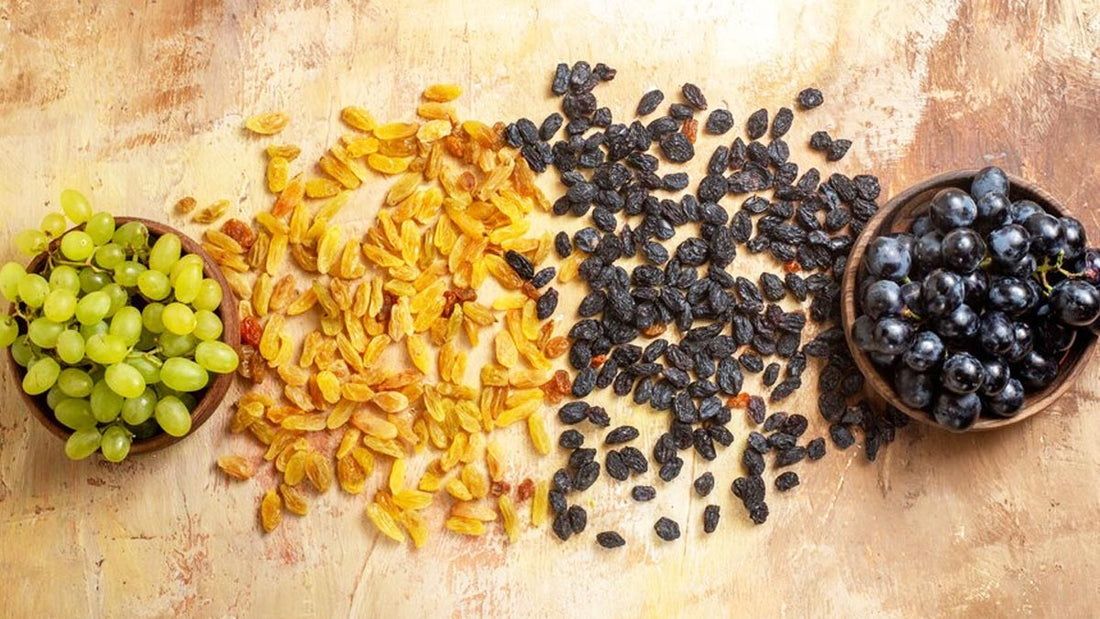What are the main differences in taste between green raisins and black raisins?
Summary: Green raisins have a milder, fruitier taste with a hint of tartness, while black raisins are sweeter and have a more intense, caramelized flavor.
The main differences in taste between green and black raisins are:
- Sweetness level: Black raisins are generally sweeter due to the caramelization process during sun-drying.
- Flavor intensity: Black raisins have a more concentrated, robust flavor compared to green raisins.
- Fruitiness: Green raisins retain more of the original grape's fruity notes.
- Tartness: Green raisins may have a slight tartness that is less prominent in black raisins.
- Aftertaste: Black raisins often have a deeper, more lingering aftertaste than green raisins.
Are green raisins and black raisins made from different types of grapes?
Summary: Green and black raisins can be made from the same grape varieties. The color difference is primarily due to the drying process rather than the grape type.
Key points about the grapes used for green and black raisins:
- Grape varieties: Both types can be made from the same grape varieties, such as Thompson Seedless or Sultana.
- Drying process: The main factor determining color is the drying method used.
- Sun-drying: Black raisins are typically sun-dried, which causes oxidation and darkening.
- Controlled drying: Green raisins are often dried in controlled environments to preserve their light color.
- Exceptions: Some specialized raisin types may use specific grape varieties, but this is not the norm for common green and black raisins.
Which type of raisin is sweeter - green or black?
Summary: Black raisins are generally sweeter than green raisins due to the caramelization of sugars during the sun-drying process.
Comparison of sweetness between green and black raisins:
- Black raisins: Typically sweeter due to sugar concentration during sun-drying.
- Green raisins: Less sweet, retaining more of the original grape's sugar profile.
- Caramelization: The sun-drying process of black raisins leads to sugar caramelization, enhancing sweetness.
- Moisture content: Black raisins often have less moisture, concentrating sugars further.
- Perception: The intense flavor of black raisins can make them taste sweeter even if sugar content is similar.
Are there any health benefits specific to green raisins that black raisins don't have, or vice versa?
Summary: Both types offer similar health benefits, but green raisins may retain slightly more vitamins, while black raisins might have higher antioxidant levels due to the drying process.
Health benefits comparison:
| Aspect | Green Raisins | Black Raisins |
|---|---|---|
| Vitamin retention | Slightly higher | Slightly lower |
| Antioxidant content | Moderate | Higher |
| Fiber content | Similar | Similar |
| Mineral content | Similar | Similar |
| Calorie content | Similar | Similar |
How do the textures of green and black raisins compare?
Summary: Green raisins tend to be softer and more plump, while black raisins are chewier and have a slightly tougher skin due to the sun-drying process.
Texture comparison between green and black raisins:
- Moisture content: Green raisins generally have higher moisture content, making them softer.
- Skin texture: Black raisins have a slightly tougher skin due to sun exposure.
- Chewiness: Black raisins are typically chewier than green raisins.
- Plumpness: Green raisins often appear more plump and retain more of their original grape shape.
- Mouthfeel: Green raisins provide a juicier mouthfeel, while black raisins offer a denser texture.
Can I use green and black raisins interchangeably in recipes?
Summary: In most cases, green and black raisins can be used interchangeably in recipes, but the final taste and texture may vary slightly.
Considerations for using green and black raisins in recipes:
- Flavor impact: Black raisins may impart a stronger flavor to dishes.
- Visual appeal: The color difference can affect the appearance of the final dish.
- Moisture in baked goods: Green raisins might add slightly more moisture to baked items.
- Texture in cooked dishes: Black raisins may hold their shape better in cooked dishes.
- Personal preference: Choose based on the desired taste and texture for your specific recipe.
Is there a difference in shelf life between green and black raisins?
Summary: Black raisins generally have a slightly longer shelf life than green raisins due to their lower moisture content and the protective effects of sun-drying.
Shelf life comparison:
- Average shelf life: Black raisins can last 6-12 months, while green raisins typically last 4-6 months.
- Moisture content: Lower moisture in black raisins contributes to their longer shelf life.
- Storage conditions: Both types should be stored in airtight containers in a cool, dry place.
- Refrigeration: Refrigerating can extend the shelf life of both types by several months.
- Signs of spoilage: Watch for mold, off-odors, or unusual texture changes in both types.
Is one type of raisin more expensive than the other? If so, why?
Summary: Green raisins are often more expensive than black raisins due to the more controlled and costly drying process required to maintain their color.
Factors affecting the price of green and black raisins:
- Production process: Green raisins require more controlled drying, increasing production costs.
- Yield: The drying process for green raisins may result in lower yields compared to black raisins.
- Demand: Black raisins are more commonly produced and consumed, potentially lowering their price.
- Seasonality: Availability of fresh grapes and drying conditions can affect pricing for both types.
- Market perception: Green raisins are often perceived as a premium product, influencing their price.
Conclusion
While green and black raisins share many similarities, they offer distinct characteristics in taste, texture, and culinary applications. Black raisins are sweeter and chewier, making them ideal for snacking and baking, while green raisins provide a milder flavor and softer texture, perfect for adding a subtle fruity note to dishes. Both types offer valuable nutritional benefits, with slight variations in vitamin retention and antioxidant content. When choosing between green and black raisins, consider your recipe requirements, personal taste preferences, and budget. Ultimately, both varieties of raisins can be delicious and nutritious additions to your diet, offering versatility in cooking and snacking options.




